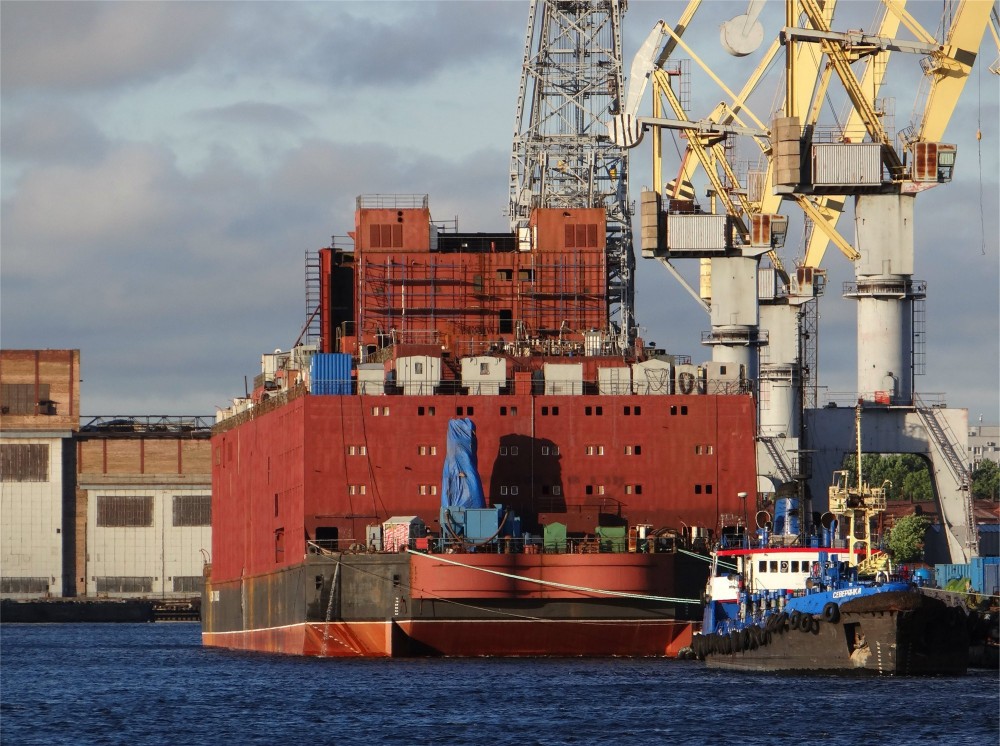
The system built to manage Russia’s nuclear legacy is crumbling, our new report shows
Our op-ed originally appeared in The Moscow Times. For more than three decades, Russia has been burdened with the remains of the Soviet ...
News

Publish date: March 14, 2017
News
Environmentalists and several politicians in Northwest Russia have raised alarm about reports that the Baltic Shipyard will fuel the floating nuclear power plant it has been building for the last seven years by Christmas.
The Akademic Lomonosov, as the plant is called, has undergone a fitful 13-year construction, beginning in 2006 at Sevmash and since 2008, in St. Petersburg, and its launch has been plagued by delays, lawsuits, bankruptcy proceedings, property disputes and continuous budget shortfalls.
Current plans, as announced by Rosenergoatom, Russia’s nuclear utility, are to fuel the floating plant by December, and tow it to its mooring in Chukotka, on the far eastern Kamchatka Peninsula, by November of 2019.
That’s already two years behind the most recently updated schedule. Previous fueling and towing plans had said the Akademik Lomonosov would arrive in Pevek, its final port, by October 2017.
 Nuclear reactor installation on the Akademik Lomonosov. (Photo: Baltiisky Zavod)
Nuclear reactor installation on the Akademik Lomonosov. (Photo: Baltiisky Zavod)
Yet, even that is seven years later than the originally scheduled launch, which was optimistically slated for 2010. In 2008, the builders cited needing more time for “new technological operations” and pushed the unveiling of the plant back to 2011, the first rock in an avalanche of delays.
When it’s complete, the vessel will be Russia’s first-ever floating nuclear power plant, a controversial honor eclipsed only by the Sturgis, designed and launched by the United States in 1967 and decommissioned in 1976.
And it’s supposed to be the first of many. In 2015, amid a mire of delays and shocking price spikes to complete the Akademik Lomonosov, state nuclear corporation Rosatom rolled out plans to build a second, more compact, floating plant by 2030. And that this plant, the company said, would be built in 40 percent less time by eliminating on-vessel storage of spent nuclear fuel and crew quarters.
Reports from that time in the business daily Kommersant carried head-scratching quotes from several anonymous sources within Rosatom, who said they didn’t know how the new design would house the crew or what they would do with the spent fuel.
Some of those sources even acknowledged that building the first plant was a misadventure. Using a floating nuclear plant as an area’s single source of energy was, they said, a bad idea, which called into question the reason for building the plant in the first place. Ever since, discussion of a second floating plant has dropped off.
The present fueling schedule for the Akademik Lomonosov’s two KLT-40 reactors, carried by Interfax, have been known since May.
But last week, the St Petersburg offices of the Yabloko opposition party issued a public statement calling the plans “unacceptable,” and cited that the fueling operations would take place in the middle of Russia’s second most populous city. Greenpeace has likewise criticized the prospective fueling operations.
The Baltic Shipyard is located within a kilometer of the Winter Palace, the Hermitage Museum and St. Issaac’s Cathedral. Yabloko went on to say that the fueling operations should be put to public discussions among the city’s 5 million residents, and called the apparent skirting of that dialogue a “disgrace.”
The fueling procedure announced by Rosenergoatom will see some 360 kilograms of low-enriched uranium-235 loaded into the vessel’s reactors in the shipyard. According to an analysis by the Independent Barents Observer news portal, that could mean a year’s worth of reactor tests and mooring trials for the nuclear plant would take place in the heart of the city.
Baltic Shipyard, which is one of Russia’s oldest shipyards, has a long history of building the bulk of the country’s nuclear icebreaker fleet. Bellona’s general director, Nils Bømher, while appreciating the controversy surrounding the planned fueling procedures, said the dangers presented by the reactor fuel itself were relatively minor.
“Fresh nuclear fuel contains relatively little radioactivity and is therefore not the main issue to be afraid of regarding the floating NPPs,” he said Tuesday.
Instead, as Bellona has long maintained, it’s the very operation of the Akademik Lomonosov that poses the greatest threats.
Pevek, the mooring point for the vessel, is relatively remote, making the plant a sitting duck for terrorists. Any accidents aboard the floating plant would be devastating for the environment as well because its far-flung location would hinder proper containment.
Most of all, the project represents budgetary quicksand. When the Akademic Lomonosov originally hit the drawing board in 2001, its price tag was projected to be about $150 million. By 2010, that had risen three times to $550 million. The balloon kept expanding, hitting $740 million by 2013. That year, another estimate showed the project cresting $1.2 billion.
Most nuclear plants come in well over budget, but the runaway costs of the Akademic Lomonsov are setting records even at that. But as surely as costs rise, so do the delays become longer. The Russian government may well hope to put off the final bill as long as possible, the single plan that seems possible to fulfill.

Our op-ed originally appeared in The Moscow Times. For more than three decades, Russia has been burdened with the remains of the Soviet ...

The United Nation’s COP30 global climate negotiations in Belém, Brazil ended this weekend with a watered-down resolution that failed to halt deforest...

For more than a week now — beginning September 23 — the Zaporizhzhia Nuclear Power Plant (ZNPP) has remained disconnected from Ukraine’s national pow...

Bellona has taken part in preparing the The World Nuclear Industry Status Report 2025 and will participate in the report’s global launch in Rome on September 22nd.